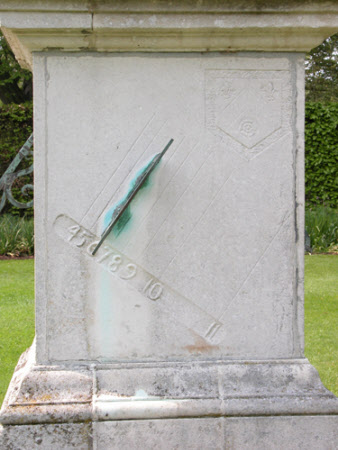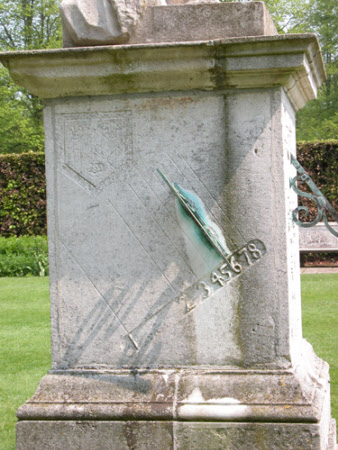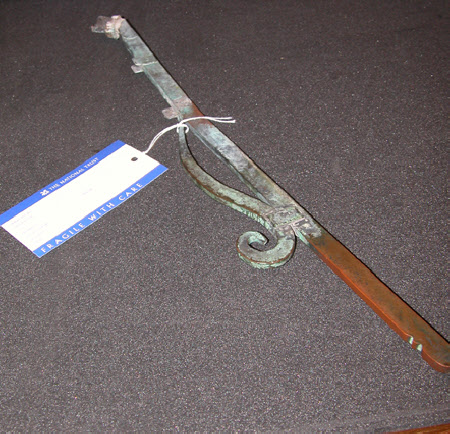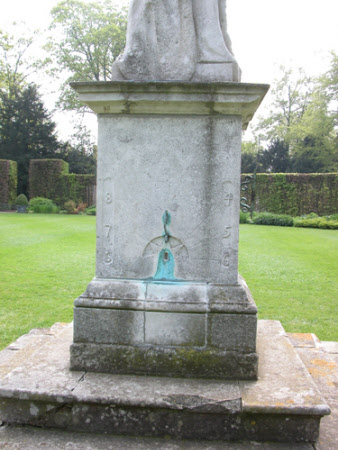Tīw (Tyr)
John Michael Rysbrack (Antwerp 1684 – London 1770)
Category
Art / Sculpture
Date
circa 1730
Materials
Portland stone
Measurements
194 x 94 x 136 cm
Place of origin
Great Britain
Order this imageCollection
Anglesey Abbey, Cambridgeshire
NT 516622
Summary
Portland stone, Tīw or Tyr, John Michael Rysbrack (Antwerp 1684 – London 1770), c. 1730. A unique full-length figure of the Norse/Saxon deity Tīw or Týr by John Michael Rysbrack. The god rendered as a bearded elderly man, standing in contrapposto, looking out, wearing a long hooded cloak made of a whole pelt, the fur facing inwards. His proper left hand is held to his right breast, his proper right hand, held out, would have once held a sceptre, which was later replaced by a sickle, now also broken off (Roper 1964, p. 69). One of seven statues of Saxon 'Gods of the Days of the Week' carved by Rysbrack in around 1730 for Lord Cobham's gardens at Stowe. Considerably weathered. Mounted on an original limestone base, the front engraved with the runic characters for Tyr, and on a 20th-century stone pedestal with four-sided sundial (NT 518552). When the statue came to Anglesey Abbey it was known as a figure of Chronos or Time, which accounts for the incongruous sundial pedestal.
Full description
An ancient and enigmatic deity, Tiw (Old English) or Tyr (Old Norse) can be traced back to the Indo-European Sky Father ∗Dyeus, the Shining One, Zeus among the Greeks and Jupiter among the Romans. Tiw is alternately described as the son of the giant Hymir and of Odin, and was once considered supreme god in the Norse pantheon. He is associated with war, justice and the law and was thus equated to Mars by the Romans. Tiw was identified by Tacitus as Tuisto, the legendary divine ancestor of the Germanic peoples who led them out of Asia into Europe after the destruction of Babel. He is the namesake of the Tiwaz rune, a letter of the runic alphabet corresponding to the Latin letter T, and, in Germanic languages, of Tuesday (Tīw's Day). Tiw is one of seven unique statues of Saxon deities believed to have given their names to the English days of the week. Mona, Wodn, Thor, Friga, Seatern and Sunna complete the group produced by John Michael Rysbrack for Stowe’s second architect, James Gibbs (1682-1754), working on behalf of Viscount Cobham. The figures were carved from around 1728 to 1730 and mounted by 1731, as they are described in a poem published that year by the English poet and Cobham's nephew, Gilbert West (1703-56). A 1739 map by Sarah Bridgeman, widow of Stowe’s landscape gardener Charles Bridgeman, shows that the deities were originally placed in a grove called ‘the Saxon Temple’ situated near Nelson’s Seat, a monument by Sir John Vanbrugh demolished at the end of the 18th century. Defoe writes that the Temple lay within a ‘solemn Grove’, where ‘seven Saxon Deities presiding over the several Days of the week’ were ‘placed in Niches’ around an ‘Altar, as for Sacrifice’. Although no formal record of authorship exists, Rysbrack is named as the sculptor by his acquaintance George Vertue, who, in the celebrated notebooks, copied out passages from Benton Seeley’s 1745 guide to Stowe and annotated them with his own remarks, writing that the statues in the Saxon Temple were ‘done by Mr Rysbrack’ (Vertue Notebooks III, Walpole Society, XXIII, 1934, p. 133). This attribution is supported by the fact that a terracotta model of ‘a Saxon god’ was auctioned at the sculptor’s sale on 25 January 1766 (lot 44). Rsybrack is understood to have modelled the deities on engravings in Richard Verstegan’s, ‘A Restitution of Decayed Intelligence in Antiquities’, an account of the German origins of the English nation, published in Antwerp in 1605 and London in 1634. Tiw, described among the ‘Idols’ worshiped by the Saxons ‘while they were Pagans’, is illustrated as monarch and law-giver with the attribute of a sceptre, wearing ‘his garment of a skinne’ (Verstegan 1634, p. 71). Although Rysbrack kept an extensive library of prints and books, ‘A Restitution’ was not listed among books for sale when the sculptor auctioned his library in February 1764. It is well known that Viscount Cobham, a prominent Whig, designed Stowe, one of the most influential gardens in English history, to reveal his political beliefs, employing sculpture and architecture to communicate ideas about English history and good government in the wake of the Glorious Revolution. These ideas form the basis of Gilbert West’s poetic description of his uncle’s estate, the political motivations for installing the Saxon Temple conveyed in the stanza below: Forsaking now the covert of the Maze, Along the broader Walk’s more open space, Pass we to where a sylvan Temple spreads Around the Saxon Gods, its hallow’d Shades. Hail! Gods of our renown’d Fore-Fathers, hail! Ador’d Protectors once of England’s Weal. Gods of a Nation, valiant, wise and free, Who conquer’d to establish Liberty! To whose auspicious Care Britannia owes Those Laws, on which she stands, by which she rose. Still may your Sons that noble Plan pursue, Of equal Government prescrib’d by you. Nor e’er indignant may you blush to see, The Shame of your corrupted Progeny! England’s ancient Northern European heritage was invoked by the Whigs, often with little regard for historical fact, to justify their deposition of the Roman Catholic Stuarts and their institution of a parliamentary monarchy succeeded by the Protestant House of Hanover. The Whigs also drew comparisons between the English parliament and the Anglo-Saxon 'witenagemot', an assembly of nobles who advised the monarch on the administration of the kingdom in an attempt to prevent autocracy. A staunch Parliamentarian, the ideal of Saxon political freedom was at the heart of Viscount Cobham’s Whig principles. In the context of Stowe, the Saxon deities represent the triumph of the Anglo-Saxon tradition in England, of Protestantism over Catholicism, of parliamentary democracy over absolutism, of Whig politics over Tory. They are part of a much larger scheme glorifying ideals of political liberty and freedom of thought, expressed elsewhere at Stowe in the temples of the Elysian Fields (such as the Temple of British Worthies containing busts by Rysbrack), the Temple of Friendship, and the Gothic Temple dedicated 'To the Liberty of our Ancestors', where the seven deities were reinstalled by 1744. By 1777 the statues had been moved to a grove near the Gothic Walk, north of the Gothic Temple, where they remained until the estate was sold in 1921. The statues were dispersed and sank into obscurity until Susan Moore found two of the figures, Wodn and Thuner, in a Hampshire garden in 1982 (Country Life, 20 May 1982, letters and Moore 1995, pp. 250-1). Tiw was sold to Lord Fairhaven by Bert Crowther in the 1940s. Mona and Friga were purchased in the 1990s by the Buckinghamshire County Museum (AYBCM: 1991.100.1 and AYBCM: 1994.116.1), while Woden was sold at Christie's to a private collector in 1985. Thuner was purchased for the Victoria & Albert Museum, London, in 1985 (A.10-1985). Seaturn and Sunna were sold at Christie’s in July 1997, the former acquired for a private collection, the latter purchased to accompany Thuner at the V&A (A.2-1997). Alice Rylance-Watson 2019
Provenance
One of seven statues of Saxon 'Gods of the Days of the Week' commissioned from John Michael Rysbrack by Richard Temple, 1st Viscount Cobham (1675-1749) c. 1730 for the 'Saxon Temple' at Stowe; moved to the Gothic Temple in 1744; removed between the Gothic Temple and the Cobham Pillar by 1793, remaining there until 1921; sold Jackson Stops, 'Stowe, near Buckingham, The Ducal Estate and Contents of the Mansion', 4-28 July 1921 and 11-13 October 1922, p. 225, lots 3793-9, 'A beautifully carved figure, executed in stone, of 'The Seven Deities' (by Rysbrack), denoting days of the week on a large stone pedestal'; purchased by Urban Huttleston Rogers Broughton, 1st Lord Fairhaven (1896-1966) as a figure of 'Father Time' from Bert Crowther; bequeathed by Lord Fairhaven in 1966 with the house and the rest of the contents.
Credit line
Anglesey Abbey, The Fairhaven Collection (The National Trust)
Marks and inscriptions
Base, front: In runic characters translated as 'TIW'
Makers and roles
John Michael Rysbrack (Antwerp 1684 – London 1770), sculptor
References
Kenworthy-Browne 1985: John Kenworthy-Browne, 'Rysbrack’s Saxon Deities', Apollo, no. 122 (September 1985), pp.220-27. Verstegan, Richard, ca. 1550-1640 restitution of decayed intelligence: in antiquities. 1634., pp. 71-2. Branston 1955: Brian Branston, Gods of the North, London and New York 1955, pp. 51, 109-11, 135-36. Roper 1964: Lanning Roper, The Gardens of Anglesey Abbey, Cambridgeshire. The Home of Lord Fairhaven, London 1964, p. 69, pl. 47. Christie, Manson & Woods 1971: The National Trust, Anglesey Abbey, Cambridge. Inventory: Furniture, Textiles, Porcelain, Bronzes, Sculpture and Garden Ornaments’, 1971, p. 161.






